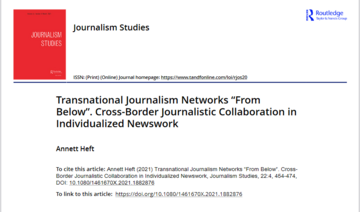
Based on information provided by Hostwriter members and Dataharvest – the EIJC participants, this study carves out (1) central motives, (2) types and characteristics of cross-border research collaborations, and (3) the advantages and challenges of the method as perceived by practitioners “from below.” We argue that bottom-up collaborations contribute to a normalization of the practice through small-scale, less institutionalized, and less binding forms that enable a gradual transition towards a new mindset in the broader field. The above pioneering platforms foster a developing network of open-minded and multicultural practitioners.
The author observes a shift towards a recognition of collaborative practices within the journalistic field appearing since the 1990s in the United States (US) and Europe.
Beyond large-scale and highly institutionalized examples such as the ICIJ projects, there is a wealth of projects at medium and smaller levels and beyond the specific fields of investigative or data journalism. This variety suggests that such collaboration in transnational journalism networks might become more established as a journalistic practice.
The author argues that to learn more about the practicability and sustainability of different types of collaborations, more research is needed that takes contexts related to country, culture, and project into account.
Tags: Investigative journalismThe content of this article can be used according to the terms of Creative Commons: Attribution-NonCommercial 4.0 International (CC BY-NC 4.0) . To do so use the the wording "this article was originally published on the Resource Centre on Media Freedom in Europe" including a direct active link to the original article page.

